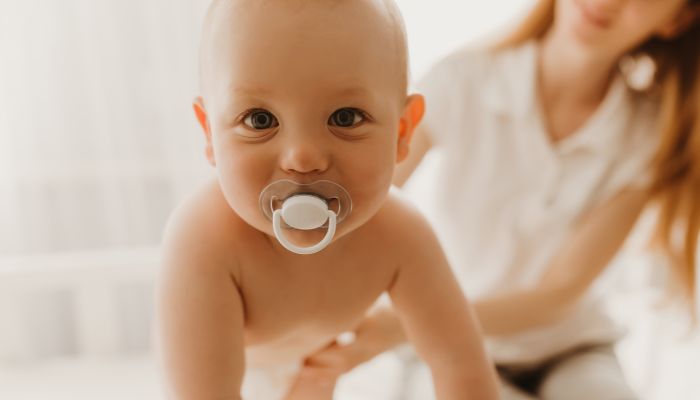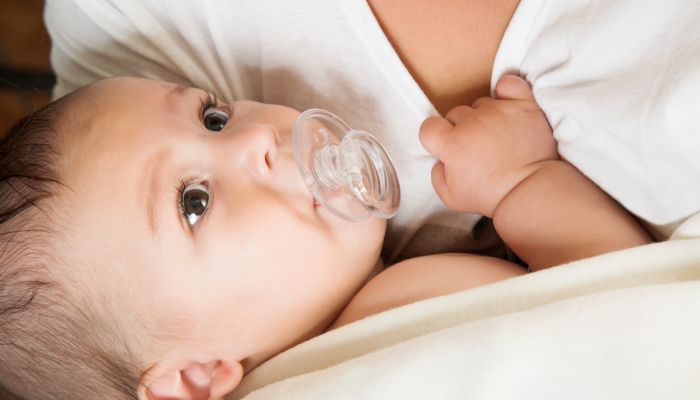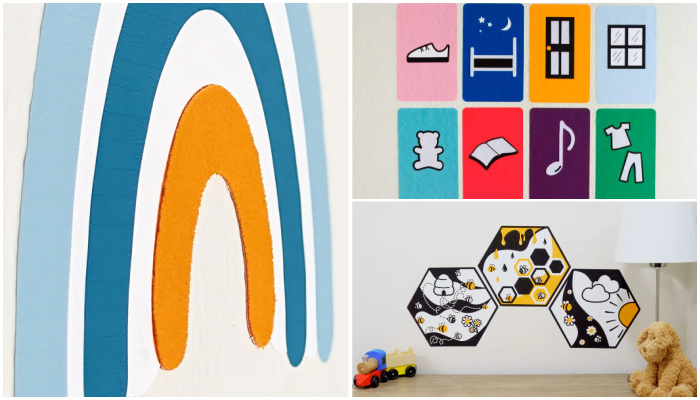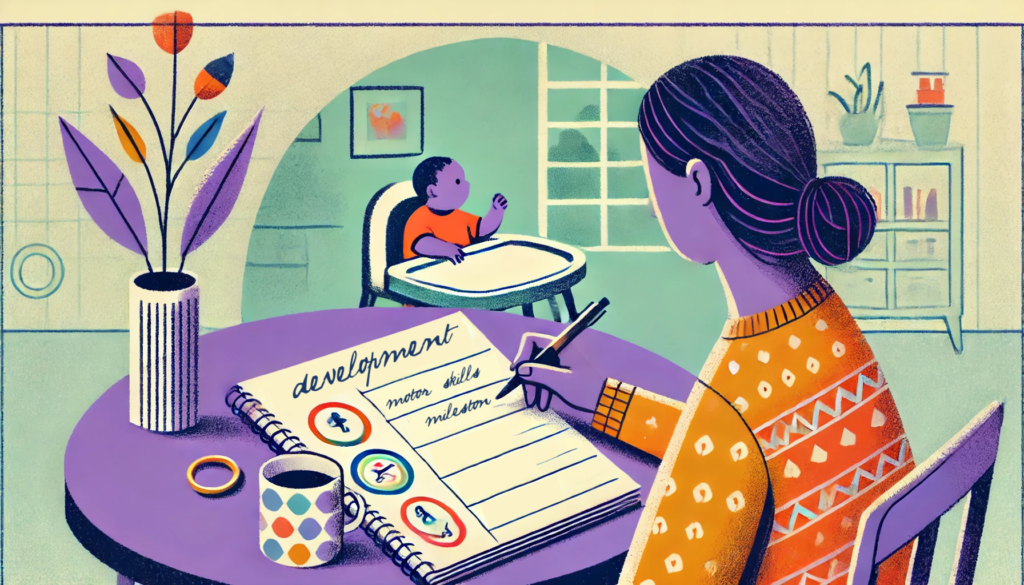Help! How Do I Keep a Pacifier in My Baby’s Mouth?

Whether you’re a new mom or not, you probably already know that a pacifier helps soothe young infants, leading to a better night’s rest for them and for you. What’s more, the American Academy of Pediatrics (AAP) has stated that using a pacifier at night can help reduce the risk of SIDS, as it keeps babies in a lighter phase of night sleep.
The tricky thing about using a nighttime pacifier is keeping it in your baby’s mouth so both of you can get a restful, deep sleep. If you’ve often wondered how to keep a pacifier in your baby’s mouth, there are a few possible solutions you can try.
These include using orthodontic shapes, ensuring the nipple is the right size for your baby’s age, and ensuring your baby has a good suck reflex to properly hold the pacifier in their mouth. Let’s take a closer look at baby pacifiers and what steps you can take to keep them in place.

Why Do Babies Spit Out Pacifiers?
There are a variety of reasons why your baby may continue to spit out their pacifier. Determining the root cause can help you determine the best solution to stop this behavior. It can also give you insight into what your baby may need instead of a pacifier habit. Your baby may be hungry and in need of food, or you could have an overstimulated baby and the pacifier is no longer soothing to them.
Style
The first thing to consider is the pacifier style. You can find pacifiers in a wide range of different styles. Some pacifiers are simple, and others are more elaborate, but your baby will likely have a preference for one over the other. In the end, you may need to try multiple pacifiers until you find the best pacifier for your baby.
Some babies prefer the rounded tip nipple. It’s one of the more common and most affordable pacifier styles you will see being sold, which is great when you need to keep multiple on hand for when your baby spits out a pacifier.
If your baby isn’t loving the rounded tip, you can consider trying an orthodontic nipple instead. This type of pacifier is designed to better fit the shape of your baby’s mouth. It gives them a much better grip and helps improve their suck reflex strength.
Texture
The second thing to consider is the pacifier’s texture. Not all pacifiers are created equal, and some may be much more malleable and comfortable in your baby’s mouth than others. Some pacifier materials respond to warmth better than others, and will gently mold to your baby’s mouth shape as they suck on it.
If your baby is a strong sucker, you may want to look for a firmer nipple. While they might prefer the softer feel and texture, it can lead to a choking hazard with babies that have a very strong suck reflex. In this case, it’s much safer for your baby if you find a pacifier nipple with good firm pressure.
Size
Finally, the size of the nipple can play a big role in why it may be getting spit out. Pacifiers can be found in dozens of sizes so they can grow as your baby grows.
You will need to continue upgrading your baby’s pacifier size as they grow to ensure it continues to fit well in their mouth. If your baby keeps spitting out their pacifier, it may be because the pacifier is too small or too large.
Nipple Confusion
This term describes babies that were either breastfed or bottle-fed and are then switched to the opposite. For example, if a baby starts by being breastfed, but needs to switch to a bottle later on, they may experience nipple confusion in which they have trouble latching, or refuse to latch, onto the new nipple being offered.
The action a baby uses to nurse from a breast is very different in the action they use when nursing from a bottle. In some cases, using a pacifier can help a breastfed baby learn to take a bottle as it gets them used to having a strange new object in their mouth.

How to Keep a Pacifier in Your Baby’s Mouth
Keeping a pacifier in baby’s mouth is sometimes easier said than done. You will have to pay attention to your baby’s cues that they want a pacifier instead of you deciding when they should take one. If your baby keeps spitting out pacifiers, or your baby resists taking them altogether, they may simply have decided they are done with it and want something else at the time.
Pacifier Cords
When a baby keeps spitting out a pacifier, or the pacifier keeps falling out as they move around, you will need to figure out a way to keep the pacifier in their mouth. Otherwise, you will be spending a lot of time constantly placing it back in their mouth yourself.
When a baby is awake and you are nearby to supervise them, you can use a pacifier cord to keep the pacifier nearby when it gets dropped or spit out. However, a pacifier cord should not be used at bedtime and naptime, as it can cause a strangulation hazard.
Encourage Better Sucking
If a pacifier easily falls from your child’s mouth, it could be a sign of poor suction or low muscle tone. You can help improve your baby’s sucking strength if you gently tug on the pacifier periodically as they are actively enjoying it.
Don’t yank it out of their mouth entirely, but give it a gentle tug and see how your baby responds. This feeling of the pacifier falling out of their mouth may encourage them to suck it back in. If your newborn wakes up when the pacifier falls out, this method can help reduce the chance of it being lost as your baby moves around.
Things to Avoid
- Don’t force a pacifier back into your baby’s mouth. If they don’t want the pacifier at that time, they may have other needs such as being hungry, having tummy issues, or you may have an overtired baby.
- Don’t use the pacifier as a way to stop your baby from crying. It’s important for a mother to be able to distinguish between the different cries of her baby. Is your baby sick, tired, or hungry? Learning these cries helps you to take care of the issue, and help your baby cry less in the long-run.
- Don’t put a pacifier in the mouth of a sleeping baby. Your baby can fall asleep with a pacifier, but don’t place it back in if your baby is still sleeping soundly.

Understanding Non-Nutritive Sucking
This phrase is used for babies that suck on a pacifier, thumb, or other object without receiving any food or other nourishment. Non-nutritive sucking is a self-soothing mechanism babies use to relax or feel calm.
For premature babies, or babies that have had issues latching onto a nipple, non-nutritive sucking can have many benefits. The first is that it helps develop normal sucking strength and patterns, and teaches the baby to both suck and swallow. This is helpful for babies that are having trouble feeding as it can promote better feeding.
Neonatal departments often use non-nutritive sucking practices for babies that need to be tube-fed. The babies associate the sucking action with a full stomach and, in turn, will learn to feed naturally.
Other benefits of non-nutritive sucking can include an increase in oxygenation through better breathing habits, a reduction in “oral aversion” in babies that dislike having things in their mouth, and the stimulation of stomach enzymes so your baby can digest milk and formula more easily.
Pacifier FAQ
Is pacifier use safe?
As long as the pacifier in your child’s mouth is made from high-quality latex or silicone material, and is of the right size for your baby’s age, pacifier use is perfectly safe. It’s also important to remember other pacifier safety guidelines, like not letting baby sleep with a pacifier cord. Similarly, you shouldn’t use a pacifiers attached to stuffed animals overnight.
Pacifiers can be an effective way for your baby to learn how to self-soothe throughout the day or night. Sucking on a pacifier can also encourage better muscle tone in the jaws and other areas of the face and neck which a baby will need later in life.
How do you get a baby to suck on a pacifier?
Some babies may need persuasion to suck on a pacifier. One of the easiest ways to trigger their natural sucking reflex is by placing the pacifier in their mouth then giving it a gentle tug. This tugging feeling will help encourage your baby to suck, naturally pulling the pacifier back into the proper position.
Can you give the pacifier back to your baby during the night?
If your baby wakes up after dropping their pacifier and cries for it back, you can absolutely give it back to them. However, a pacifier should never be put in the mouth of a sleeping baby. Additionally, once a baby reaches a few months of age, they can learn to place the pacifier back into their own mouth during the night which saves you a lot of trips to the crib.
Do pacifiers help prevent sudden infant death syndrome (SIDS)?
While the exact relationship is not known, a variety of studies including those done by the AAP have found that babies who use pacifiers can have their risk of SIDS reduced drastically.
Some thoughts are that the use of a pacifier helps keep the baby in a lighter stage of sleep so they can be alerted to potential smothering or overheating issues while in their crib at night.

The information WonderBaby provides is not intended to be, and does not constitute, medical or other health advice or diagnosis and should not be used as such. Always consult with a qualified medical professional about your specific circumstances.
Related Posts

Parenting
Sensory Wall Art: 5 Tips to Create a Room Your Blind or Low-Vision Child Will Love
Even if your child can’t see their surroundings, personalizing and decorating their room with thoughtful, sensory-friendly design can make a big difference in their confidence, independence, and joy.

Development, Special Needs
How to Track Milestones for Developmentally Delayed Babies
Parents of developmentally delayed babies can explore practical tools and strategies to track milestones, celebrate progress, and support their child’s unique developmental journey.

Fine and Gross Motor
5 Alternatives to Tummy Time for Babies with Motor Development Challenges
Does your baby struggle with tummy time due to motor development challenges? These alternatives to tummy time will offer the same benefits.